|
Due to rapid advances in infrared detector technology, the development
of adaptive optics for ground based work and the commitment to infrared
missions from space organizations such as NASA, ESA and ISAS, the future
of infrared astronomy is extremely bright. Within the next decade, infrared
astronomy will bring us exciting discoveries about new planets orbiting
nearby stars, how planets, stars and galaxies are formed, the early universe,
starburst galaxies, brown dwarfs, quasars and interstellar matter.
Below is a summary of currently active and future infrared projects.
Click on the links to learn more. For links to submillimeter missions
such as
SWAS and microwave missions such as
MAP,
see
NSSDC's Astrophysics Missions.
For information on past missions see the section on the
background of infrared astronomy.

 Start-Duration: First observations (north) in April
1997, (south) in March 1998 - 3.5 years
Start-Duration: First observations (north) in April
1997, (south) in March 1998 - 3.5 years
Description:
Highly uniform digital imaging survey of the entire sky
using two ground based telescopes: at Mt. Hopkins, AZ for viewing the
northern sky and at Cerro Tololo, Chile for viewing the southern sky.
Goals:
To produce:
a) a catalog containing highly accurate astrometric and
photometric information for approximately 300 million unresolved sources,
b) a catalog containing positional, photometric and basic morphological
information for approximately one million resolved sources, mostly galaxies;
c) an Atlas of nearly 2 million 8.5 by 17 arcminute images with 1 arcsecond
pixels, covering the entire sky in three near infrared bands.
Key science
goals include probing the large-scale structure of the Milky Way and the
Local Universe, performing an accurate census of stars in the solar
neighborhood, and discovering brown dwarfs and active galactic nuclei.
Wavelengths:
J H and Ks bands centered at 1.25, 1.65 and 2.17 microns.

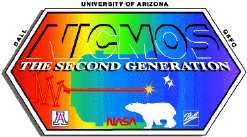 Start-Duration:
Attached to the Hubble Space Telescope in February 1997
Start-Duration:
Attached to the Hubble Space Telescope in February 1997
Description:
An infrared array consisting of 3
cameras and 3 spectrometers.
Goals:
Provide spectra and high resolution images in the near infrared of regions
in space.
Wavelengths:
0.8 - 2.5 microns

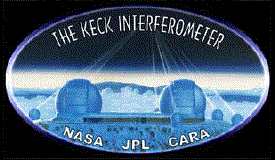 Start-Duration:
Began operation in 2001
Start-Duration:
Began operation in 2001
Description:
The Keck Interferometer Project will combine the twin
Keck Telescopes
to form an interferometer.
The Keck Interferometer is part of
NASA's Origins program
and will use adaptive optics to remove the effects of atmospheric
turbulence.
Goals:
To detect planets around nearby stars in the infrared.
In visible light, the light from a star is millions of times brighter than
the light from a planet. The visible light from a planet is hidden by the
brightness of the star that it orbits. In the infrared, where planets
have their peak brightness, the brightness of the star is reduced.
This makes it possible to detect planets in the infrared.
Wavelengths:
1.6 - 10 microns

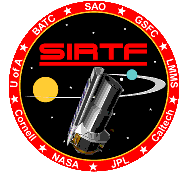 Start-Duration:
2003 - 2.5 to 5 yrs
Start-Duration:
2003 - 2.5 to 5 yrs
Description:
SIRTF will be NASA's next "great observatory" in space. SIRTF will consist
of a 0.85 meter telescope, a camera, spectrograph and photometer.
SIRTF will be much more sensitive than prior infrared missions and will
study the universe at a wide range of infrared wavelengths.
Like ISO, SIRTF will be operated as an observatory.
Goals:
The SIRTF mission will concentrate on gathering data on:
protoplanetary and planetary debris disks, brown dwarfs and super
planets, Ultraluminous galaxies and active galactic nuclei, and the early
universe. SIRTF can also be used to study the outer solar system, early
stages of star formation and the origin of chemical elements.
Wavelengths:
3.5-180 microns

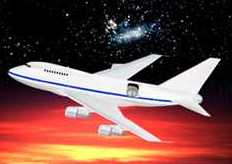 Start-Duration:
Scheduled to begin operations in 2004
Start-Duration:
Scheduled to begin operations in 2004
Description:
SOFIA, a joint project between NASA and the German Space Agency, will be
optical/infrared/sub-millimeter telescope mounted in a Boeing 747.
Designed as a replacement for the very successful Kuiper Airborne Observatory,
SOFIA will be the largest airborne telescope in the world.
Goals:
Flying at altitudes between 41,000 and 45,000
feet, SOFIA will take infrared observations high above most of the
infrared absorbing atmosphere and will be able to observe at all infrared
wavelengths.
SOFIA will be used to study interstellar clouds, star and planet formation,
activity in the center of the Milky Way and the composition of planets
and comets in our solar system.
As with the Kuiper Airborne Observatory, teachers and students will be allowed
to fly on SOFIA to learn about infrared astronomy.
Wavelengths:
The entire IR range

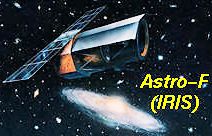 Start-Duration:
Launch in 2004 - 1.5 years
Start-Duration:
Launch in 2004 - 1.5 years
Description:
IRIS is an infrared space mission planned by the Japanese space agency ISAS.
It will have a near and mid infrared camera and a far infrared scanner.
Goals:
IRIS will be used to study the formation and evolution of galaxies,
star formation, interstellar matter and extra-solar systems.
Wavelengths:
2-25 microns and 50-200 microns

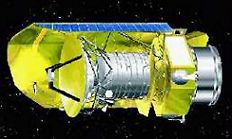 Start-Duration:
Launch planned in 2007 - > 3 years
Start-Duration:
Launch planned in 2007 - > 3 years
Description:
The Herschel Space Observatory is a proposed
European Space Agency infrared-submillimeter mission.
It is part of ESA's Horizon 2000
Scientific Program.
Goals:
The Herschel Space Observatory will perform
spectroscopy and photometry over a wide range of infrared wavelengths.
It will be used to study
galaxy formation, interstellar matter, star formation and the atmospheres of
comets and planets.
The current plan is to merge Herschel with ESA's
PLANCK, mission.
Wavelengths:
80 - 670 microns

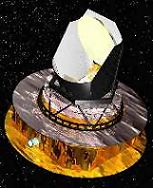 Start-Duration:
Launch planned in 2007
Start-Duration:
Launch planned in 2007
Description:
PLANCK is a proposed
European Space Agency (ESA) far infrared-submillimeter mission.
It is part of
ESA's Horizon 2000 Scientific Program
Goals:
PLANCK will image the
anisotropies of the Cosmic Background Radiation over the entire sky with
exceptional resolution and sensitivity.
Wavelengths:
350-10,000 microns

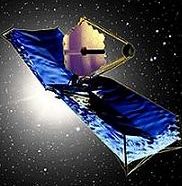 Start-Duration:
Launch planned for 2010
Start-Duration:
Launch planned for 2010
Description:
The James Webb Space Telescope is an infrared space mission which is part of
NASA's Origins program
Goals:
The James Webb Space Telescope will have extremely good sensitivity and
resolution, giving us
the best views yet of the sky in the near-mid infrared.
It will be used to study the early universe and the formation of galaxies,
stars and planets.
Wavelengths:
0.5 to 20 microns

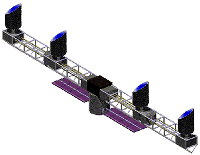 Start-Duration:
Launch planned for 2012 - > 6 years
Start-Duration:
Launch planned for 2012 - > 6 years
Description:
TPF is envisioned as a long baseline interferometer space mission
and is a part of
NASA's Origins program
An interferometer is a group of telescopes linked together across a "baseline".
By gathering data with several telescopes linked in this way, very precise
position measurements can be made.
Goals:
TPF will concentrate on detecting terrestrial planets
(small and rocky planets - like Mercury, Venus, Earth and Mars) outside
our solar system and orbiting other stars. By studying near infrared spectral
lines, astronomers can also detect several molecules which can indicate how
earth-like these planets are.
Another long-term space mission which has been identified by NASA is a far-
infrared interferometer, covering infrared wavelengths not included in the
TPF mission. This mission, which has not yet been give a name, would study
the earliest and coolest phases of star and planetary disk formation.
Wavelengths:
7-20 microns (the best range for searching for Earth-like planets)

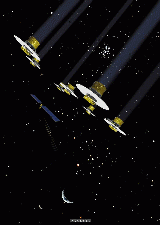 Start-Duration:
After 2015
Start-Duration:
After 2015
Description:
Darwin is a candidate for the European Space Agency's infrared interferometer
space mission
Goals:
The primary goal of Darwin is to search for Earth-like planets around nearby
stars, and to search for signs of life on these planets by studying infrared
spectral lines in their atmospheres.
Darwin would also be used as a general infrared astronomy observatory.
The Darwin project would consist of about 6 individual telescopes combined
as an interferometer about 100 yards across and would orbit between Mars
and Jupiter, beyond the zodiacal dust which radiates infrared light at
the wavelengths which will be used to search for planets.
Wavelengths:
Not yet defined - near infrared
|


